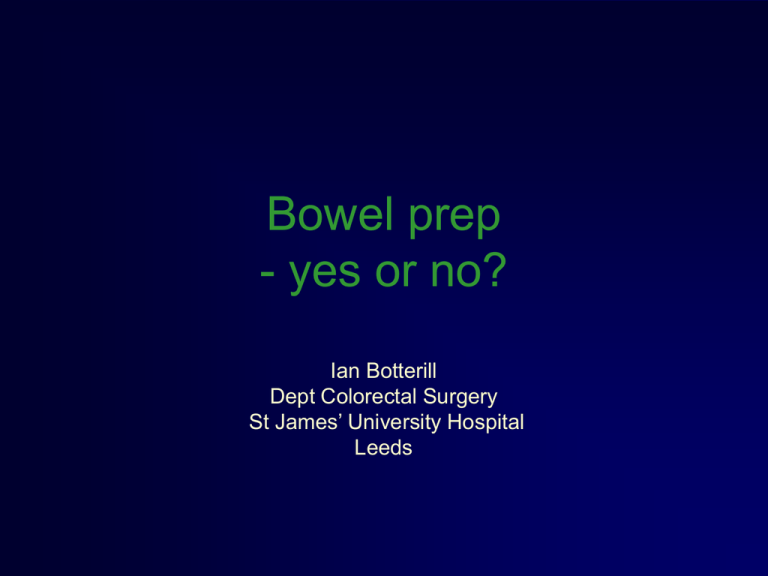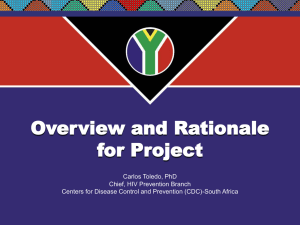Bowel prep - yes or no?
advertisement

Bowel prep - yes or no? Ian Botterill Dept Colorectal Surgery St James’ University Hospital Leeds Goligher (1970’s) “…there are great advantages to operating on an empty colon …if the growth is stenotic, 10-14 days should be set aside … excellent preparation may be obtained with 30l via the irrigation machine …my preference is 5-6 days, initial softening then vigorous expulsion with castor oil … finally, massive colonic irrigation in the terminal phase ….this process can be exhausting for frail, elderly patients ….some suggest that it may lead to hypovolaemia and circulatory imbalance” Surgery of the Anus, Rectum & Colon 3rd edition 1975 Heresy…. • Irving et al 1987 (BJS) - retrospective, uncontrolled study - no bowel prep - 72 1y anastomoses - no leaks - 8% wound sepsis The BJS response “this paper which challenges accepted surgical practice, is a veritable little bomb of a paper, brief, iconoclastic and disrespectful of hallowed tradition in surgery” Professor David Johnston, BJS 1987;74:553-4 Justification for using bowel prep • Poor mechanical bowel prep associated with anastomotic dehiscence1 • “Notwithstanding recent publications ….intuitively it is unfathomable to believe that stool does not have deleterious effect on a healing anastomosis” 2 1 Irvin, Goligher BJS 1973;60:461-4 2 Surgery for the Colon, Rectum & Anus 2nd ed. Gordon & Nivatvongs. 1999 Downside of bowel prep Hypovolaemia - ↓ cardiac output / shock - ↓ coronary artery filling - colonic mucosal ischaemia Electrolyte disturbance - fits - dysrhythmias - myopathy - nausea Diarrhoea - lack of sleep &vitality Colonic explosion Bowel prep - creation of a need for ‘pre-optimisation’? • Pts undergoing major elective surgery (large DGH) • Randomised to: - standard care - HDU pre-optimisation (fluids +/- 2 inotropes) guided by PAFC / CVP • Active treatment group -required 1.5l IV fluid -↓ M&M & ↓ LoS Wilson et al. BMJ 1999;318:1099-1103 Cochrane review 2004 • Inclusion criteria - randomised clinical trials, elective surgery - leak rate (1y outcome) clearly stated • Stratified (where possible) - low anterior resection - colo-colic / intra-peritoneal anastomosis Cochrane review -2y outcome measures • Mortality • Peritonitis • Re-operation • Wound sepsis • Extra-abdominal (infectious / non-infectious) • Total infection rate Recruitment to Cochrane review • Oral bowel prep (+/- enema) versus nil • Standard meta-analysis methodology Studies included / excluded • 14 studies identified - 5 excluded: no control (3) elemental diet in controls (1) ill-defined outcomes (1) • 9 included - 7 english / 1 spanish / 1 portugese - 3/9 abstracts - 9 trials: 789 oral prep / 803 no oral prep Cochrane review: problems…. • Power calculation 0/9 • Intention to treat analysis 0/9 Cochrane review -casemix of included studies • No anastomosis - 2/9 included pts without an anastomosis - 2/9 included pts ultimately not anastomosed • Preoperative radio / chemoradiotherapy - 0/9 studies reported use • Antibiotic prophylaxis - 2/9 did not describe use • Demographics - 3/9 did not describe demographics / operation - 1/9 described significant diff’s Cochrane review: -exclusion criteria in the papers • No description of exclusion criteria (4/9) • Recent antibiotics / bowel prep (3/9) • Failure to tolerate prep (2/9) • No anastomosis performed (2/9) Potential bias in included papers (1) • None used ITT analysis -3/9 withdrew pts after randomisation (5%,31%,10%) • Selection bias: 5/9 randomisation not described • Blinding: 8/9 not blinded • Performance bias: nil detected Potential bias (2) • Attrition bias: -4/9 did not describe withdrawls • Detection bias -4/9 did not describe diagnostic processes • Reporting bias - 5/9 no stratification of leaks into anastomotic subgroups Results: 1y outcome measure (anastomotic leak) Low rectal colon total Bowel prep 9.8% 2.9% 6.2% No bowel prep 7.5% 1.6% 3.2%* *p=0.003 2y outcome measures • Focal peritoneal sepsis -5.7% (bowel prep) -2.5% (no prep) p=0.05 • Other 2y endpoints - no significant differences Sensitivity analysis • Exclusion studies with inadequate randomisation - OR unchanged, significance lost (T2 error) • Exclusion of studies in abstract form - no effect • Exclusion of study including children - no effect • Exclusion of studies including no anastomosis - ↓ OR of leak 2.1 (2.3) p=0.03 Length of stay? L.o.S. only quoted in 1/9 articles reviewed! Henrik Kehlet 24hrs & 48hrs post sigmoid colectomy • Multimodal peri-operative recovery package • Managed care pathways Summary of published data (to 2004) Number Age (yrs) ASA 3&4 Op’n Stay (d) BO (d) Morbidity Mortality Readmission 53 74 20 R&L colectomy 2 (2-60) 2 8% 4% 15% 16 71 1 Sigmoid colectomy 2 (2-9) 2 6% nil nil 31 69 14 rectopexy 3 2 nil 3% nil 29 55 reversal Hartmann’s 3 2 7% nil 7% 58 44 40 ASA 2+ R&L colectomy 4 3 3 7% nil 7% 14 / 11 64 / 68 Possum matched R&L colectomy 3 v. 7 3 Cochrane conclusions for practice • Oral bowel prep “… not been shown to be valuable … may lead to ↑ anastomotic leakage … oral bowel prep should be omitted” Cochrane conclusions -implications for research “results of this show the necessity of completing more, properly designed trails” …blinding & stratification …consider pre-op radiotherapy …inclusion & exclusion criteria …define discharge criteria, dropout & outcome measures Proposed avoidance of oral prep… • Colon surgery -R hemi / extended R hemi / subtotal -L hemi* • Permanent stoma - Hartmann’s - APER* - PPC & ileostomy • Proctology -Abdominal rectopexy* -Anal sphincter repair* -Rectal flap advancement* • PPC & IPAA* * Use enema Proposed cases for oral prep? • Generally need defunctioning - TME • Undergone RT / CRT • Possible need for on-table colonoscopy - the ‘unknown’ colonoscopist - severe sigmoid diverticular disease - small tumour - consider tattooing for laparoscopic resection Summary Dogma (n.) : - a doctrine or code of beliefs accepted as authorative -a doctrinal notion asserted without regard to evidence or truth Recognise morbidity of bowel prep Recognise limitations of current evidence base - effect of radiotherapy - type of procedures & pts suitable for accelerated care








